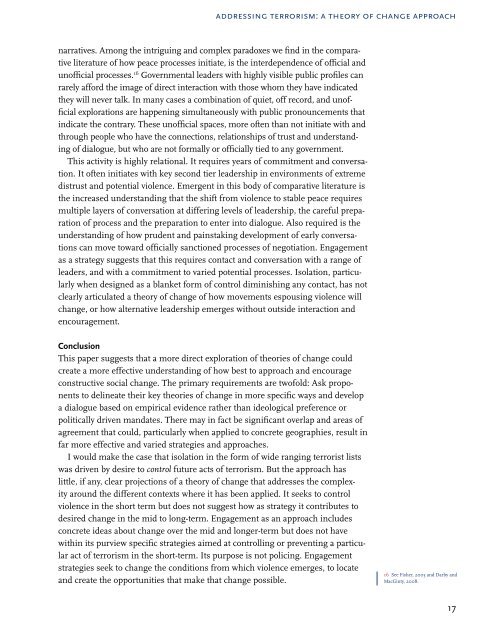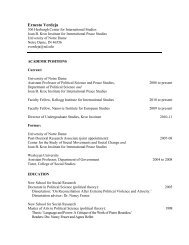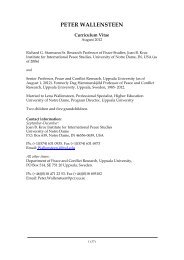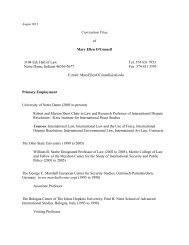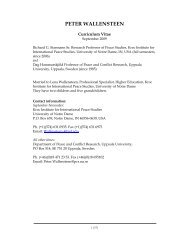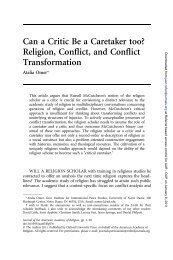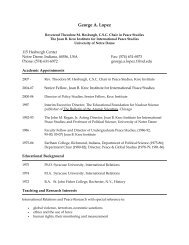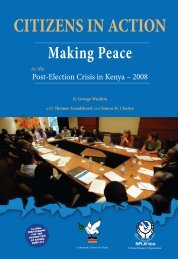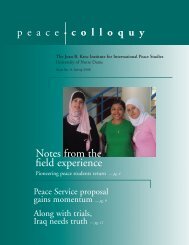Somalia: Creating Space for Fresh Approaches to Peacebuilding
Somalia: Creating Space for Fresh Approaches to Peacebuilding
Somalia: Creating Space for Fresh Approaches to Peacebuilding
Create successful ePaper yourself
Turn your PDF publications into a flip-book with our unique Google optimized e-Paper software.
addressing terrorism: a theory of change approach<br />
narratives. Among the intriguing and complex paradoxes we find in the comparative<br />
literature of how peace processes initiate, is the interdependence of official and<br />
unofficial processes. 16 Governmental leaders with highly visible public profiles can<br />
rarely af<strong>for</strong>d the image of direct interaction with those whom they have indicated<br />
they will never talk. In many cases a combination of quiet, off record, and unofficial<br />
explorations are happening simultaneously with public pronouncements that<br />
indicate the contrary. These unofficial spaces, more often than not initiate with and<br />
through people who have the connections, relationships of trust and understanding<br />
of dialogue, but who are not <strong>for</strong>mally or officially tied <strong>to</strong> any government.<br />
This activity is highly relational. It requires years of commitment and conversation.<br />
It often initiates with key second tier leadership in environments of extreme<br />
distrust and potential violence. Emergent in this body of comparative literature is<br />
the increased understanding that the shift from violence <strong>to</strong> stable peace requires<br />
multiple layers of conversation at differing levels of leadership, the careful preparation<br />
of process and the preparation <strong>to</strong> enter in<strong>to</strong> dialogue. Also required is the<br />
understanding of how prudent and painstaking development of early conversations<br />
can move <strong>to</strong>ward officially sanctioned processes of negotiation. Engagement<br />
as a strategy suggests that this requires contact and conversation with a range of<br />
leaders, and with a commitment <strong>to</strong> varied potential processes. Isolation, particularly<br />
when designed as a blanket <strong>for</strong>m of control diminishing any contact, has not<br />
clearly articulated a theory of change of how movements espousing violence will<br />
change, or how alternative leadership emerges without outside interaction and<br />
encouragement.<br />
Conclusion<br />
This paper suggests that a more direct exploration of theories of change could<br />
create a more effective understanding of how best <strong>to</strong> approach and encourage<br />
constructive social change. The primary requirements are twofold: Ask proponents<br />
<strong>to</strong> delineate their key theories of change in more specific ways and develop<br />
a dialogue based on empirical evidence rather than ideological preference or<br />
politically driven mandates. There may in fact be significant overlap and areas of<br />
agreement that could, particularly when applied <strong>to</strong> concrete geographies, result in<br />
far more effective and varied strategies and approaches.<br />
I would make the case that isolation in the <strong>for</strong>m of wide ranging terrorist lists<br />
was driven by desire <strong>to</strong> control future acts of terrorism. But the approach has<br />
little, if any, clear projections of a theory of change that addresses the complexity<br />
around the different contexts where it has been applied. It seeks <strong>to</strong> control<br />
violence in the short term but does not suggest how as strategy it contributes <strong>to</strong><br />
desired change in the mid <strong>to</strong> long-term. Engagement as an approach includes<br />
concrete ideas about change over the mid and longer-term but does not have<br />
within its purview specific strategies aimed at controlling or preventing a particular<br />
act of terrorism in the short-term. Its purpose is not policing. Engagement<br />
strategies seek <strong>to</strong> change the conditions from which violence emerges, <strong>to</strong> locate<br />
and create the opportunities that make that change possible.<br />
16 See Fisher, 2005 and Darby and<br />
MacGinty, 2008.<br />
17


